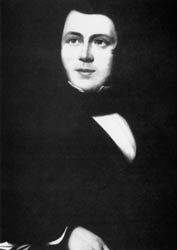John Hughes Bennett (1812-1875)
John Hughes Bennett, as depicted in the
adjacent portraits, was considered a man of high intellect and an
outstanding teacher, whose methods served as a model to other teaching
institutions beyond Edinburgh. He has been described as the founder of
phisiology because he introduced the teaching of physiology by practical
classes and number of advances in physiology in Scotland can be
attributed directly to him. His obituarist wrote in the British
Medical Journal, "When all the controversies with which his name is
associated will have been forgotten, the important services which he
rendered to practical medicine will be even more highly appreciated than
they are at present."

Key contributions to medicine:
Published the first case of Leukaemia (1845)
"It is moreover the same conclusion which Bennett came to in the much
discussed matter of priority between us when he observed a case of
individual leukaemia some months before I saw my first case." Rudolf
Virchow (1858)
Introduced practical experimental histology and the use of the
microscope for the diagnosis of disease into the scottish medical
curriculum.
Opposed bloodletting and the indiscriminate use
of drugs and was an important influence in changing British therapeutic
practices during the second half of the ninteenth century.
Advocated the use of cod-liver oil and
restorative treatments for tuberculosis and other debilatating deseases.
"John Hughes Bennett's contribution to tuberculosis were many. He was
responsible for saving many patients from the rigours associated with
the antiphlogistic therapeutic regimen. He recognised that teberculosis
disease could cure spontaneoulsly. His observations and his attempts to
achieve cures were to set the scene for later interventions which were
also to originate in Edinburgh" A G Leitch (1995)
Emphasised the need for collaboration between
medical and scientific specialities in order to advance modern medicine
". . . in the struggle between advancing science, and a routine
practice, those who desire the welfare of the professionshould never
forget that it can only be maintained by an earnest love of truth. This
is to be promoted not by vague assertion and vulgar douse but by
rational investigation and sound arguement" John Hughes Bennett
John Hughes Bennett (1812-1875)
1812 31st August, born and educated in Exeter,
England.
1829 Apprenticed to a surgeon in Maidstone,
Kent.
1833 Enrolled at University of Edinburgh to
read medicine.
1836 Elected as President of the Royal Medical
Society and of the Royal Physical Society of Edinburgh and
Vice-President of the Anatomical and Physiological Society. Published
first article in London Medical Gazette On the Anatomy and Physiology of
the Otic Ganglion.
1837 Graduated MD with highest honours and gold
medal. Dissertation on The Physiology and Pathology of the Brain. Began
2 year's of postgraduate studies in Paris. Founder and first president
of the English-speaking Medical Society in Paris.
1838-1841 Attended medical schools and
hospitals in Germany.
1841 Returned to Edinburgh. Extra-academical
lecturer on histology, physiology, pathology and the diagnosis of
disease illustrated by the microscope. The first to teach the clinical
use of the microscope systemically and the practical teaching of
physiology and pathology in Britain. Published Treatise on Cod Liver
Oil, reintroducing it as an important therapeutic agent.
1842 Fellow of the Royal College of Physicians
of Edinburgh. Fellow of the Royal Society of Edinburgh.
1843 Appointed Pathologist and Keeper of
Statistics, Royal Infirmary of Edinburgh. Physician to the Royal
Dispensary and to the Fever Hospital.
1844 Married Jessie Samuel at Kirknewton.
1845 Lecturer in medicine at University of
Edinburgh Medical School. Published On the Frequent Spontaneous Cure of
Pulmonary Consumption and its Treatment and Case of Hypertrophy of the
Spleen and Liver in which Death took place from Suppuration of the
Blood, the first recorded case of leukaemia, then known as
leucocythaemia, in the Edinburgh Medical and Surgical Journal.
1846 Editor and later proprietor of the Monthly
Journal of Medical Science.
1848 Elected to the chair of the Institutes of
Medicine and clinical teacher of medicine as professor within the
University of Edinburgh.
1851 Published On Leucocythaemia or White Cell
Blood, a collection of case studies. Founder and President of the
Physiological Society of Edinburgh.
1853 Published On the Pathology and Treatment
of Pulmonary Tuberculosis.
1855 Unsuccessful candidate for the chair of
the Practice of Physic.
1856 Published Clinical Lectures on the
Principles and Practice of Medicine, an authoritative textbook in 5
editions in Britain and 6 in America to 1868.
1857 Challenge to the practice of blood
letting.
1858 Appointed by the Senate of Edinburgh
University as their envoy to Parliament on the Universities (Scotland)
Bill.
1866 Published The Restorative Treatment of
Pneumonia which had the rare distinction of being translated and
published in Japan.
1869 Supported the admission of women medical
students in Edinburgh.
From: The University of Edinburgh - Leukaemia
Research Fund
John Hughes Bennett Laboratory